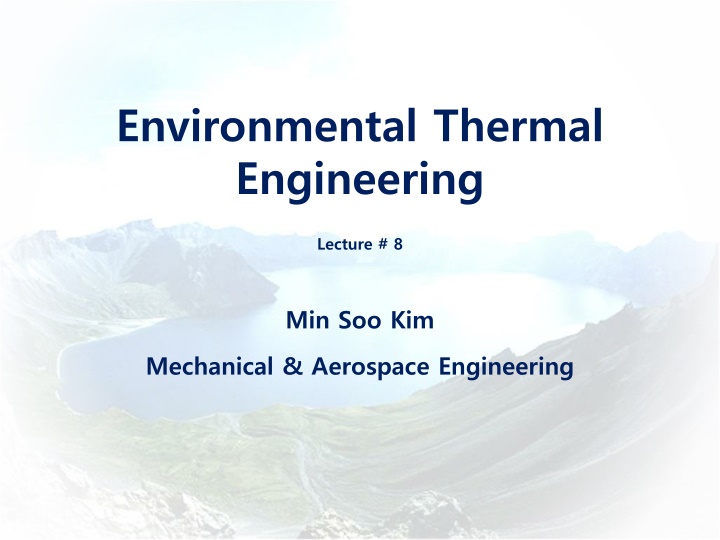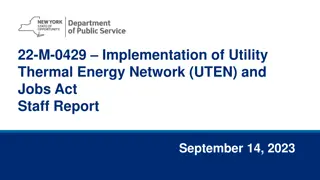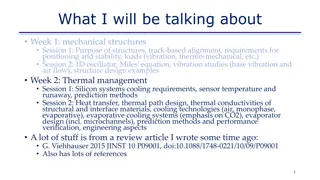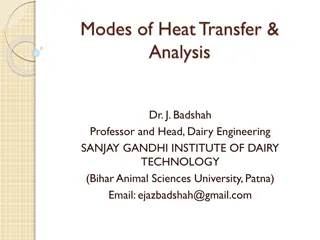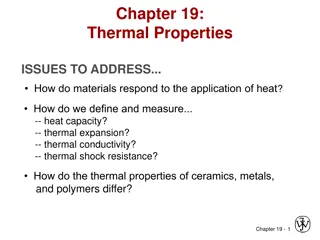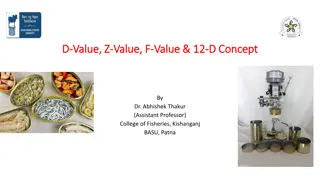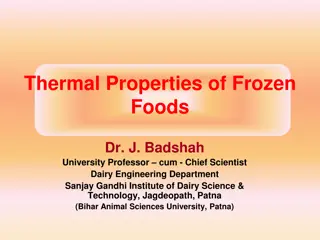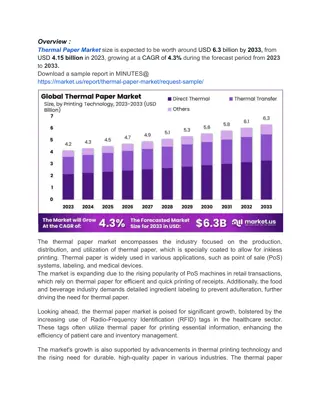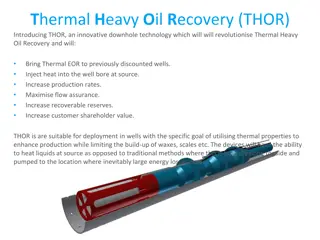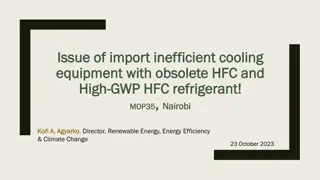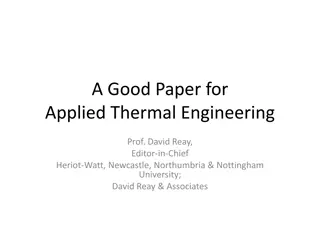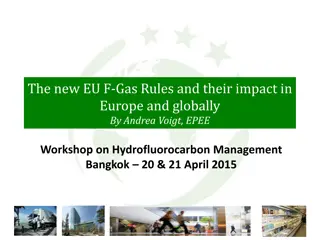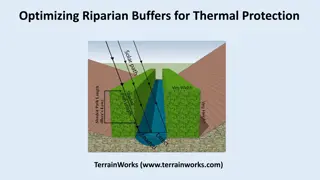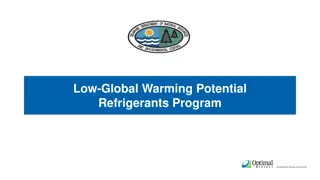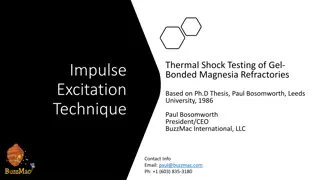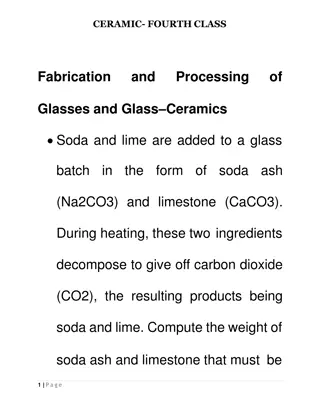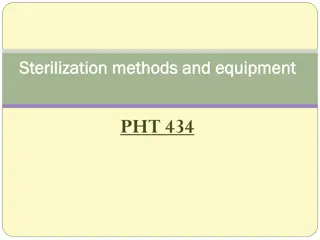Refrigerants Overview in Thermal Engineering
Covering a detailed analysis of various refrigerant types including Halocarbons, Hydrocarbons, Inorganic compounds, and Zeotropic mixtures. Learn about the composition, properties, and notations of popular refrigerants like CFC, HCFC, HFC, and more, in the field of environmental thermal engineering.
Download Presentation

Please find below an Image/Link to download the presentation.
The content on the website is provided AS IS for your information and personal use only. It may not be sold, licensed, or shared on other websites without obtaining consent from the author.If you encounter any issues during the download, it is possible that the publisher has removed the file from their server.
You are allowed to download the files provided on this website for personal or commercial use, subject to the condition that they are used lawfully. All files are the property of their respective owners.
The content on the website is provided AS IS for your information and personal use only. It may not be sold, licensed, or shared on other websites without obtaining consent from the author.
E N D
Presentation Transcript
Environmental Thermal Engineering Lecture # 8 Min Soo Kim Mechanical & Aerospace Engineering
Type of refrigerant Halocarbon CFC, HCFC, HFC, R-12, R-32, R-134a Hydrocarbon R-50, R-170, R-290, R-600, R-1270 Inorganic compound Ammonia(R-717), water Carbon dioxide R-744
Type of refrigerant 1. CFC (chlorofluorocarbon ) - Compound that consists of carbon, chlorine, fluorine - R-12, R-113, R-114, R-115 - Most high ODP(Ozone Depletion Potential - They have an effect on global warming 2. HCFC (hydrochlorofluorocarbon) - Compound of CFC which has at least one hydrogen atom. - R-22, R-123, R-124, R-141b, R-142b - With substitution of a portion of Cl with H, ODP has reduced - They have a little effect on global warming 3. HFC (hydrofluorocarbon) - Compound that consists of only carbon, chlorine, hydrogen - R-32, R-125, R-134a, R-143a, R-152a - No influence on Ozone layer
Notation of refrigerant Methane, Ethane, Propane series Notation (1) - Expressed on treble figures each digit is related with elements - Hundreds digit x = the number of carbon atom - 1 - Tens place y = the number of hydrogen atom+ 1 - Unit digit z = the number of fluorine Notation (2) - Adding 90 on R-xyz, which makes new notation that each digit represent the number of elements - Hundreds digit x = the number of carbon atom - Tens place y = the number of hydrogen atom - Unit digit z = the number of fluorine
Notation of refrigerant Methane, Ethane, Propane series Notation(3) - In the case that refrigerant is composed of 4 species -carbon, hydrogen, fluorine, and chlorine- the number of chlorine atom is 2x-y-z+5 - In the case that isomer exists, alphabet a or b is added for clarifying according to stability of halogen element H H | | H F | | F-C-C-F | | F F H-C-C-F | | F F R-134 R-134a Notation expressed by structure
Example Question) Figure out chemical compound of R-134a Answer) 134+90 = 224 134 Carbon = 2 Hydrogen = 2 Fluorine = 4 Carbon = 1+1 = 2 Hydrogen = 3 -1 = 2 Fluorine = 4 = 4
Notation of refrigerant 2. Zeotropic mixture refrigerant - Naming as R-400~ - Number and mass composition for component of compound should be specified in the ascending order of the boiling point 3. Azeotropic mixture refrigerant - Naming as R-500~ 4. Organic compound refrigerant - Naming as R-600~ - Butane series - Oxygen compound - Organic compound - Nitrogenous compound : R-63O : R-60O : R-61O : R-62O
Notation of refrigerant 5. Inorganic compound refrigerant - Naming as R-700 - Last two digits mean molecular weight (For example, water is named as R-718) 6. Unsaturated organic refrigerant - Naming as R-1000~ - Following notation of halocarbon at the digits under hundreds
Notation of refrigerant Refrigerant number of a kind of halocarbons Chemical name Chemical name Chemical Chemical formula formula CCl F CCl F CClF CHClF CH Cl CCl FCClF CClF CClF 11 Trichloromonofluoromethane 3 12 Dichlorodifluoromethane 2 2 13 Chlorotrifluoroethane 3 22 Monochlorodifloromethane 2 40 Methyl chloride 3 113 1,1,2-Trichlorotrifluoroethane 2 2 114 1,2-Dichlorotetrafluoroethane 2 2
Requirements for refrigerant Thermodynamical properties Thermodynamical properties - High latent heat - Low coagulation pressure - Higher critical temperature than ambient condition - Higher boiling pressure than ambient condition in low temperature - Low condensing pressure is recommended Physicochemical properties - High electric resistance of refrigerant vapor - Good heat transfer property - Proper solubility to lubricant - Low hygroscopic - Chemical stability, no spoilage - Inactivity, low corrosiveness
Requirements for refrigerant Environmental properties - No flammability and explosiveness - No toxicity - Contains are not to be damaged by refrigerant leaking - Eco-friendly one is recommended Thermal Engineering Criteria - Volumetric Capacity - COP - Discharge Temperature - Compression Ratio
General Characteristic Cl Toxic Long Atmospheric Life Available (HCFC, HFC) Flammable F H
Characteristic of refrigerants Halocarbon - Substituting saturated hydro-carbon for halogen series - Clarified to CFC, HCFC, HFC by a presence of main components hydrogen, fluorine, chlorine, carbon - CFC and HCFC is prohibited because of its environmental problem - R-143a and R-152a in HFC can substitute R-12 - R-32, R-125 and R-143a can be used as azeotropic mixture refrigerant Hydrocarbon - Refrigerant composed of only hydrogen and carbon - R-50(methane), R-170(ethane), R-290(propane), R-600(butane), R- 600a(iso-butane), R-1270(proplene) - Non-toxic, stable, eco-friendly - Large specific volume which makes small quantities of refrigerant injection - Flammability
Characteristic of refrigerants Zeotropic mixture refrigerant - Mixture of more than two pure refrigerant - Each refrigerant component has different properties so that composition of mixture changes while boiling and condensing - Temperature rises when boiling, reduces when condensing in constant pressure
Zeotropic mixture refrigerant 105 Superheated Vapor region Two- Phase region 85 Phase change curve of R-22/R- 114(Zeotropic mixture) Temperature(F) 65 Dew line 45 Subcooled liquid region 25 Bubble line 5 0 0.2 0.4 0.6 0.8 1.0 Composition(%mol)
Zeotropic mixture refrigerant Adventages - Temperature rises when the refrigerant boils in constant pressure - Temperature reduces when the refrigerant condenses in constant pressure - That is, a temperature gradient occurs in phase changing - Heat exchanger efficiency can be improved by using this charateristic Refrigerant Refrigerant Heat sink Temperature,T Temperature,T Heat sink Zeotrpic mixture refrigerant and make temperature of refrigerant and heat source parallel so that mean temperature difference and irreversibility has reduced with efficiency improvement Heat source Heat source Refrigerant Refrigerant S S Zeotropic refrigerant Pure refrigerant
Zeotropic mixture refrigerant Disadvantage 1. Large heat exchange requirement with low temperature difference q UA T = A T 2. High cost with counter-flow heat exchanger 3. The most crucial problem is that when refrigerant leaks, composition changes because component with higher vapor pressure escape first. That is, In the case of re-charging, entire refrigerant should be took back and injected newly.
Zeotropic mixture refrigerant - Mixture of more than two pure refrigerants - Differently from Zeotropic mixture, temperature is uniform while phase changing in constant pressure - Behavior of material is similar with pure material 48 Two- Phase region 44 Superheated Vapor region Temperature(F) 40 Dew line 36 azeotrope Phase change curve of R- 500(azeotropic mixture) 32 Subcooled liquid region Bubble line 28 0 0.2 0.4 0.6 0.8 1.0 Composition(%mol)
Advantages of Mixture refrigerant 1. Can improve thermodynamical properties 2. Can improve solubility with oil 3. Can reduce flammability 4. Can improve performance
Attention for environment - After finding out Freon gas and ozone layer destructing effect, attention for environmental pollution by emission has increased. And it is concretized by the climate change conventions. type CO Source Fossil fuel, Forest fire 2 CH Bacteria, Decomposition of organic matter 4 Combustion, Nitrogenous fertilizer NO 2 CFC Refrigerant, Spray
Attention for environment (1) Carbon dioxide, methane, nitrogen dioxide - criteria for 1990 (2) Alternative refrigerant (HFC, PFC) - criteria for 1995 Developed country plays a leading role for solution for environmental problem Kyoto Protocol,1997 - goal and term is set up : 2008 2012 - target for reduction (1) Carbon dioxide, methane, nitrogen dioxide - criteria for 1990 (2) Alternative refrigerant (HFC, PFC, SF6) - criteria for 1995 - Net CO2 emissions system and emission rights trade system introduced - Eco-development fund settled supporting developing countries - reduction goal has legal force - differential application through nations (1) developing countries is excluded (2) differentially applied for advanced country, East-European countries
the Climatic Change Convention Kyoto Protocol,1997 - goal and term are set up : 2008 2012 - target for reduction (1) Carbon dioxide, methane, nitrogen dioxide - criteria for 1990 (2) Alternative refrigerant (HFC, PFC, SF6) - criteria for 1995 - Net CO2 emissions system and emission rights trade system introduced - Eco-development fund settled supporting developing countries - reduction goal has legal force - differential application through nations (1) developing countries is excluded (2) differentially applied for advanced country, East-European countries Buenos Aires Plan of Action (1998) - 170 countries consent with trade permit system, clean production developing system, joint carrying system until the sixth assembly in 2000 Visualization of birth of greenhouse gas market with scale of a billion ton annually
the Climatic Change Convention Solution for greenhouse gas prohibition - Strengthening competition of industry - Improvement of efficiency, Alternation of fuel - Forest conservation and reforestation industry - Reduction of greenhouse gas emission - Regulation of emission gas Current situation of Korea - As Korea has transited to energy conservation industry, Emission of pollutant material has reduced. However, it is still higher than the level of advanced country - Most portion of greenhouse gas is due to energy area which is followed by industrial process area Greenhouse gas policy of authorities - continuous transition to energy-saving industry is needed - consideration of regulation of greenhouse gas emission and alternative material is needed.
Type of nature refrigerant Advantage Disadvantage Good property Working in low pressure HC Combustible High pressure High critical temperature and pressure CO Good property Used for ship 2 Used in industry (in large scale plant) Toxic NH 3 combustible
Type of nature refrigerant Advantage Disadvantage Non-toxic Direct usage of refrigerant H O System enlargement 2 Non-toxic AIR Applied for high speed Train in Germany Gas cycle He Gas cycle Low efficiency Used in stirring engine
